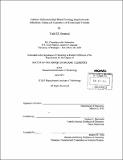Carbon-trifluoromethyl bond forming reactions and palladium-catalyzed cyanation of (hetero)aryl halides
Author(s)
Senecal, Todd D. (Todd Dale)
DownloadFull printable version (18.23Mb)
Other Contributors
Massachusetts Institute of Technology. Department of Chemistry.
Advisor
Stephen L. Buchwald.
Terms of use
Metadata
Show full item recordAbstract
Chapter 1 Nucleophilic trifluoromethyl sources were systematically examined in stoichiometric palladium experiments to determine the most efficient class of reagents for transmetallation. In conjunction with reductive elimination studies, this led to the development of the first system for the trifluoromethylation of aryl chlorides. Chapter 2 A method for the oxidative trifluoromethylation of (hetero)aryl boronic acids is reported. Bench top setup and visual reaction monitoring makes this process particularly well suited to medicinal and academic chemists. Fast reaction times allow for the trifluoromethylation of heterocyclic boronic acids that are prone to facile protodeboronation. Chapter 3 A trifluoromethylation of potassium vinyl trifluoroborates via iron catalysis has been developed. Excellent E:Z ratios are observed for styryl trifluoroborates. Initial investigations suggest a mechanistic pathway that diverges from our previous (hetero)aryl trifluoromethylation systems. Chapter 4 A highly efficient system for the palladium-catalyzed cyanation of (hetero)aryl halides is disclosed. By employing palladacycle precatalysts, cyanide binding during catalyst formation is minimized, allowing for low catalyst loadings even with unactivated aryl chlorides. The method utilizes a non-toxic cyanide source and exhibits excellent functional group tolerance, particularly of free N-H groups and typically challenging five membered heterocycles.
Description
Thesis (Ph. D. in Organic Chemistry)--Massachusetts Institute of Technology, Dept. of Chemistry, 2013. Cataloged from PDF version of thesis. Includes bibliographical references.
Date issued
2013Department
Massachusetts Institute of Technology. Department of ChemistryPublisher
Massachusetts Institute of Technology
Keywords
Chemistry.